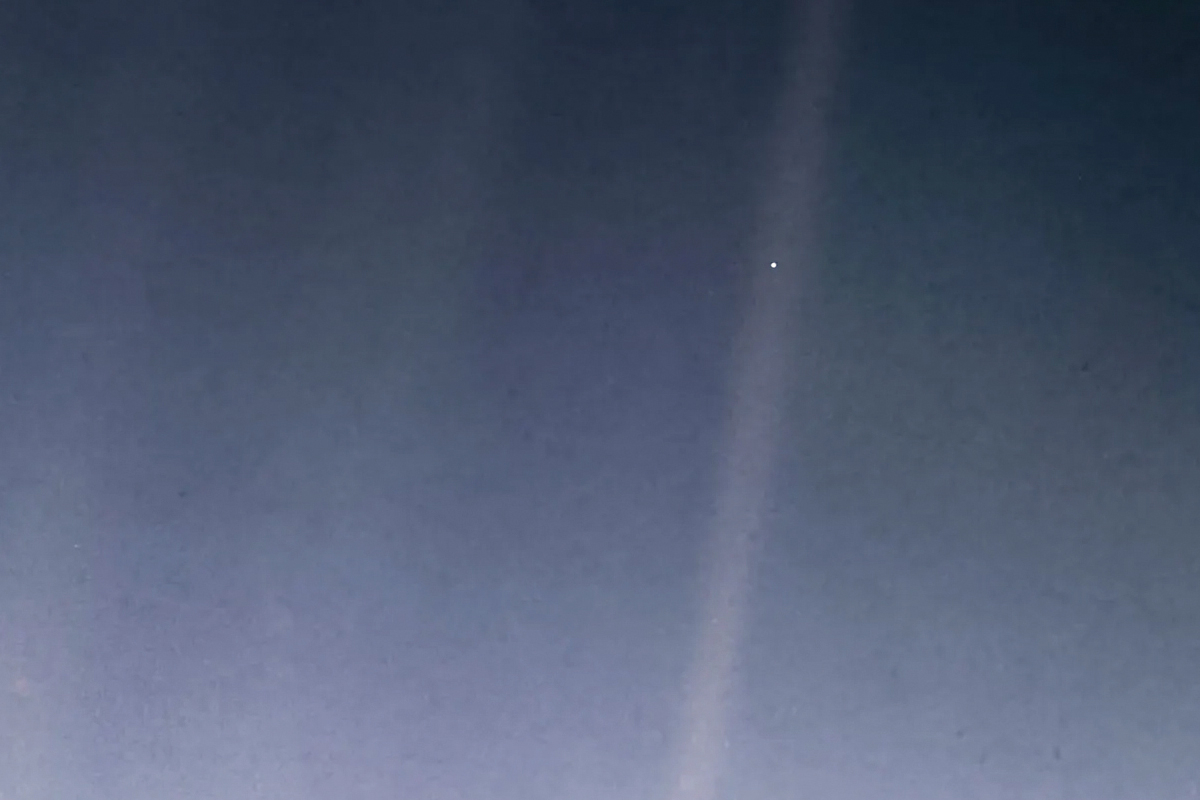We of the pale blue dot never learn
 The Pale Blue Dot is a photograph of Earth taken Feb. 14, 1990, by NASA’s Voyager 1. The image inspired the title of scientist Carl Sagan’s book, “Pale Blue Dot: A Vision of the Human Future in Space,” in which he wrote: “Look again at that dot. That’s here. That’s home. That’s us.” NASA photo
The Pale Blue Dot is a photograph of Earth taken Feb. 14, 1990, by NASA’s Voyager 1. The image inspired the title of scientist Carl Sagan’s book, “Pale Blue Dot: A Vision of the Human Future in Space,” in which he wrote: “Look again at that dot. That’s here. That’s home. That’s us.” NASA photo
My Christmas wish is that every artificial light on earth gets turned off for 24 hours between Christmas Eve and New Year’s Eve. We can look up and see the enormity of the universe without light pollution.
The beauty of the Milky Way galaxy could be seen again from cities. Even from Franklin’s Main Street. Not just by those fortunate to travel to isolated mountain tops or deserts.
Children in Gaza and Israel would look up and see the same colossal show. The child who arrives in the private family jet to their vacation home for Christmas will see the same heavenly show as the emaciated child crawling in mud in search of food.
We live on a pale blue dot of a spinning rock. Little more than 0.12 pixel in size in a photo sent back to Earth by Voyager 1 on February 14, 1990, as the spacecraft was leaving our planetary neighborhood for the fringes of the solar system. Voyager was turned around to snap earth’s photo from 4 billion miles away.
“Look again at that dot. That’s here. That’s home. That’s us. On it everyone you love, everyone you know, everyone you ever heard of, every human being who ever was, lived out their lives. The aggregate of our joy and suffering, thousands of confident religions, ideologies, and economic doctrines, every hunter and forager, every hero and coward, every creator and destroyer of civilization, every king and peasant, every young couple in love, every mother and father, hopeful child, inventor and explorer, every teacher of morals, every corrupt politician, every ‘superstar,’ every ‘supreme leader,’ every saint and sinner in the history of our species lived there — on a mote of dust suspended in a sunbeam.” Carl Sagan’s description of earth should be read on Christmas Eve as is the “Christmas Story.”
Perhaps if we turned off all the outdoor lights for a while, we might see the “Star of Wonder.” It no doubt is still out there. Three wise men, motivated by a star in the east, saddled up their camels to follow the star as a new ruler of the people of Israel was predicted.
Related Items
That “Star in the East” remains an astronomy puzzle of the first Christmas. Something beyond the laws of physics. But not beyond the laws of astronomy.
Astronomer Michael Molnar points out that “in the east” is a literal translation of the Greek phrase en te Anatole, which was a technical term used in Greek mathematical astrology 2,000 years ago. It described, very specifically, a planet that would rise above the eastern horizon just before the sun would appear. Then, just moments after the planet rises, it disappears in the bright glare of the sun in the morning sky. Except for a moment, no one can see this “star in the east.”
The Star of Bethlehem may have been some sort of astronomical event. It heralded what has become a sacred religious holiday and a worldwide cultural and commercial phenomenon. It is a time filled with traditions and practices that are both religious and secular. Popular customs include exchanging gifts, decorating Christmas trees, attending church, sharing meals and awaiting Santa Claus during a federal holiday — invented in the United States in 1870.
Christmas has, for two millenia, meant the icon of peace. Now the world is at war in more than 110 armed conflicts. War is as sure as the sun rises and sets. What happened to the Prince of Peace? Is peace and understanding no longer applicable to the rulers on this dot? We are but one of the billions of trillions of such dots floating around in the universe. I wonder if there are other earths out there with the same problems we have on our pale blue dot?
I want to recapture my Christmas beliefs of childhood. War, climate change, famine, inequality of wealth, all these are dimming my Christmas spirit of early years. Sometime, in these two thousand years since the Star of Bethlehem rose, we earthlings lost our way, lost our civility, lost peace, and the true meaning of Christmas.
Two things are infinite to me as a jaded old man: the universe and human warfare. I'm not sure about the universe. I am sure about warfare. We of the pale blue dot never learn.
(Bob Scott is a Franklin writer and photographer. He can be reached at This email address is being protected from spambots. You need JavaScript enabled to view it..)









